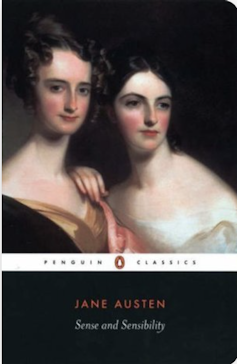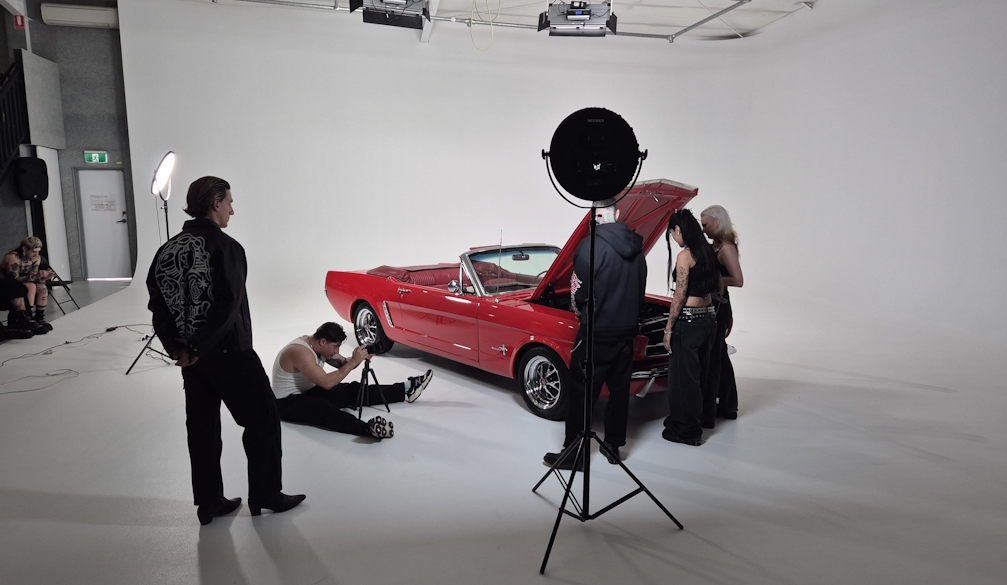
A few years ago, I turned some real estate advertisements into poems by adding line breaks:
Fantastic views of the beach, ocean, headland and hinterland,you can see the Haven,you look straight up the green grass of the Skillion
I was interested, among other things, in asking what happens when we compare the language of real estate copy with more obvious forms of poetry.
If you read a real estate ad with the same attention you might bestow on a poem you can observe how it deploys metre, metaphor, and the tropes of landscape poetry. You can note how some advertisements directly reference the sublime or the picturesque, and how others open with a rhyming couplet.
Read more:
Explainer: poetic metre
Australian poet Lucy Van characterises real estate copy as a form of poetry. No other poetry, she observes,
is more familiar to the Australian reading audience, more widely read and better understood, not only for what is said but importantly for what is not said, than the 150-200 word copy that flogs real estate.
Like other paid work involving some form of writing, real estate copywriting, or what Van calls “property poetry,” is a job that has attracted writers of literature. I know at least one Australian creative writer who has worked in this industry.
Courses on writing real estate advertisements are run by the Australian Writers’ Centre: pitched at “a writer with a passion for property or an agent looking to hone your ad writing skills.” A key learning outcome of such a course is developing the ability to “add value,” or push up the price of the property through your description of it.

Courses on real estate copy are run by the Australian Writers’ centre.
Mark Baker/AAP
The literary nature of real estate copy raises several larger questions. What is the relationship between writing and ownership of land? What is the history of writers “adding value” to landed property? How does literature normalise and respond to the inequities of private property in Australia?
19th-century real estate copy
The history of people comparing the language of real estate to poetry is at least as old as the boom in property auctions and real estate advertisements that occurred in early 19th-century England.
Newspapers frequently joked about the poetic language used in real estate auctions and ads. They consistently, if facetiously, described the prominent real estate auctioneer, George Robins, as a landscape poet, on par with William Wordsworth.
Poets of the period were also aware of the proximities between their writing and that of the burgeoning real estate industry. In his long, rambling poem Don Juan, Lord Byron compares himself to an auctioneer. This is after his lengthy description of a Gothic Abbey:
An old, old monastery once, and now Still older mansion, of a rich and rare Mix’d Gothic, such as artists all allow Few specimens yet left us can compare.
 Lord Byron, British poet (1788–1824). Portrait by Thomas Phillips.
Wikimedia Commons
Lord Byron, British poet (1788–1824). Portrait by Thomas Phillips.
Wikimedia Commons
Fittingly, Byron’s lines were taken up by his acquaintance, the auctioneer Robins, who quoted them in ads for the sale of an abbey in The Times in 1846.
Descriptive poems oriented around a house and property are, of course, older than real estate copy. An obvious example in English literature is the 17th-century Country House poem, which praises the country house owner through praising their property.
But these poems are not about houses or estates on the market. In England up until the 19th century, a real estate industry did not exist. Laws and cultural norms meant the family estate was typically passed down as an undivided parcel of land from one male heir to the next, rather than sold.
 Goodreads
These laws – and their exclusion of women and younger sons of landowning families – motivate the plots of most of Jane Austen’s novels.
They are why, in Sense and Sensibility, Marianne and Elinor Dashwood must leave the house they grew up in when their father dies, and become dependent on the charity of their relatives. Similarly in Pride and Prejudice, Mr Bennet’s house and land – since he only has daughters – will go to Mr Collins upon his death.
Laws of primogeniture kept land ownership in the hands of a small, privileged and overwhelmingly male group. They also concentrated political power in that same class. Owning land brought with it political rights, such as the right to vote.
Read more:
Friday essay: the revolutionary vision of Jane Austen
Real estate and the colony
The more contemporary attitude towards land as a commodity (something that only comes up in Austen’s later work, especially her final, unfinished novel, Sanditon) is inextricable from the history of colonialism.
In the British colonies, property law, rather than privileging an ancestral chain of ownership, was developed to dispossess First Nations people as efficiently as possible. Laws and customs were then exported elsewhere, including to imperial centres. As the Australian poets Astrid Lorange and Andrew Brooks have put it,
[t]he “vacant” land of the settler colony provided the conditions for modern property laws to be written and enacted.
Goodreads
These laws – and their exclusion of women and younger sons of landowning families – motivate the plots of most of Jane Austen’s novels.
They are why, in Sense and Sensibility, Marianne and Elinor Dashwood must leave the house they grew up in when their father dies, and become dependent on the charity of their relatives. Similarly in Pride and Prejudice, Mr Bennet’s house and land – since he only has daughters – will go to Mr Collins upon his death.
Laws of primogeniture kept land ownership in the hands of a small, privileged and overwhelmingly male group. They also concentrated political power in that same class. Owning land brought with it political rights, such as the right to vote.
Read more:
Friday essay: the revolutionary vision of Jane Austen
Real estate and the colony
The more contemporary attitude towards land as a commodity (something that only comes up in Austen’s later work, especially her final, unfinished novel, Sanditon) is inextricable from the history of colonialism.
In the British colonies, property law, rather than privileging an ancestral chain of ownership, was developed to dispossess First Nations people as efficiently as possible. Laws and customs were then exported elsewhere, including to imperial centres. As the Australian poets Astrid Lorange and Andrew Brooks have put it,
[t]he “vacant” land of the settler colony provided the conditions for modern property laws to be written and enacted.
 Goodreads
Thomas H. Ford and Justin Clemens have shown how the Australian judge, Romantic poet, and Wordsworth acolyte, Barron Field, in both his legal rulings and his poetry, established the foundations for terra nullius: the notion that Australia was an empty, unowned land.
Field’s sweeping nullification of First Nation sovereignty in his poetry and his judgements rendered the country as one without history. Australia could be an Enlightenment blank space for colonial experiments structured around a land market.
Read more:
Pastoral ponderings and settler politics: how a colonial judge and poet wrote terra nullius into law
For example, the establishment of South Australia was heavily influenced by the theories of author Edward Gibbon Wakefield, who argued for establishing a colony funded through land sales to settlers. Richard Robert Torrens, parliamentarian and briefly Premier of South Australia, further refined the settler property regime through the Torrens system, which offered a simple and effective way to establish title to land and erased First Nations’ ownership. Torrens Title quickly became standard throughout the British empire.
Goodreads
Thomas H. Ford and Justin Clemens have shown how the Australian judge, Romantic poet, and Wordsworth acolyte, Barron Field, in both his legal rulings and his poetry, established the foundations for terra nullius: the notion that Australia was an empty, unowned land.
Field’s sweeping nullification of First Nation sovereignty in his poetry and his judgements rendered the country as one without history. Australia could be an Enlightenment blank space for colonial experiments structured around a land market.
Read more:
Pastoral ponderings and settler politics: how a colonial judge and poet wrote terra nullius into law
For example, the establishment of South Australia was heavily influenced by the theories of author Edward Gibbon Wakefield, who argued for establishing a colony funded through land sales to settlers. Richard Robert Torrens, parliamentarian and briefly Premier of South Australia, further refined the settler property regime through the Torrens system, which offered a simple and effective way to establish title to land and erased First Nations’ ownership. Torrens Title quickly became standard throughout the British empire.
 Goodreads
Writer and theorist Aileen Moreton-Robinson, in her book, The White Possessive: Property, Power, and Indigenous Sovereignty, places real estate at the heart of contemporary white Australian settler consciousness. For Moreton-Robinson, Australian national identity “is built on the disavowal of Indigenous sovereignty because the nation is socially and culturally constructed as a white possession”.
Moreton-Robinson notes that the settler reaction to the 1992 Mabo decision granting native title was a “discourse of loss” and fear of “dispossession” ultimately “orchestrated to recenter white possession of the nation.”
More recently, in the Voice referendum, part of the “No” campaign presented the Voice as a conspiracy to seize privately owned property. The successful “No” campaign thrived from the inherent contradiction between Indigenous sovereignty and settler ownership of stolen land.
Read more:
No, the Voice to Parliament would not force people to give up their private land
Critiquing our real estate obsession
Goodreads
Writer and theorist Aileen Moreton-Robinson, in her book, The White Possessive: Property, Power, and Indigenous Sovereignty, places real estate at the heart of contemporary white Australian settler consciousness. For Moreton-Robinson, Australian national identity “is built on the disavowal of Indigenous sovereignty because the nation is socially and culturally constructed as a white possession”.
Moreton-Robinson notes that the settler reaction to the 1992 Mabo decision granting native title was a “discourse of loss” and fear of “dispossession” ultimately “orchestrated to recenter white possession of the nation.”
More recently, in the Voice referendum, part of the “No” campaign presented the Voice as a conspiracy to seize privately owned property. The successful “No” campaign thrived from the inherent contradiction between Indigenous sovereignty and settler ownership of stolen land.
Read more:
No, the Voice to Parliament would not force people to give up their private land
Critiquing our real estate obsession
 Goodreads
Kate Holden’s recent nonfiction book, The Winter Road: A Story of Legacy, Land and a Killing at Croppa Creek, centres on the well-publicised murder by elderly farmer Ian Turnbull of an environmental protection officer, Glen Turner. For Holden, Turner’s murder, and the sympathy Turnbull subsequently won from the public, cannot be isolated from the living legacy of invasion and colonisation.
Holden connects Turnbull’s persistence in illegally clearing vast tracts of koala habitat, and his murder of Turner, to British Enlightenment theories of property. The English philosopher John Locke, she observes, “placed emphasis on labour to morally justify the owning of property. The more work put into the land, the more settled a man was upon it.”
Holden traces associations between Locke’s ideas, the history of terra nullius and the “strange, morbid fixation in Australian myth of just how hard a person has to work on this land.” She writes,
[b]y the time of Australia’s settling, the ineluctable mark of a British citizen was land ownership. It enfranchised him, gave him rights […] Land – elemental, foundational – was the desperately prized asset in a new colony. Without it, man was only an object.
Successive governments and polls acknowledge that home ownership continues to be an “aspiration” of an overwhelming majority of Australians, even if it is out of reach to an increasing proportion of the population.
Yet the contradictions and inequities surrounding the trade in stolen land are rehearsed largely without reflection or analysis across contemporary Australian culture.
TV series like Luxe Listings Sydney (where million-dollar ocean view mansions are sold to a tiny, cashed-up clientele), The Block, and Escape from the City, participate in a nation-wide settler obsession with real estate.
“We love house hunting. We hate house hunting,” writes Van.
Read more:
'I don’t want realism. I want magic': behind the fantasy fuelling our real estate voyeurism
Michelle de Kretser’s recent novel Scary Monsters, like Van’s essays, takes a more critical approach to real estate culture.
An interest in property suffuses both halves of de Kretser’s bifurcated novel, particularly obvious in the “Lyle” section, set in a dystopic future not that different from the present. It begins with a “For Sale” sign, soon followed by interpolated real estate copy, that, in keeping with de Kretser’s novel is drily foreboding:
Here is a house that can accommodate the joys and sorrows of your family.
Goodreads
Kate Holden’s recent nonfiction book, The Winter Road: A Story of Legacy, Land and a Killing at Croppa Creek, centres on the well-publicised murder by elderly farmer Ian Turnbull of an environmental protection officer, Glen Turner. For Holden, Turner’s murder, and the sympathy Turnbull subsequently won from the public, cannot be isolated from the living legacy of invasion and colonisation.
Holden connects Turnbull’s persistence in illegally clearing vast tracts of koala habitat, and his murder of Turner, to British Enlightenment theories of property. The English philosopher John Locke, she observes, “placed emphasis on labour to morally justify the owning of property. The more work put into the land, the more settled a man was upon it.”
Holden traces associations between Locke’s ideas, the history of terra nullius and the “strange, morbid fixation in Australian myth of just how hard a person has to work on this land.” She writes,
[b]y the time of Australia’s settling, the ineluctable mark of a British citizen was land ownership. It enfranchised him, gave him rights […] Land – elemental, foundational – was the desperately prized asset in a new colony. Without it, man was only an object.
Successive governments and polls acknowledge that home ownership continues to be an “aspiration” of an overwhelming majority of Australians, even if it is out of reach to an increasing proportion of the population.
Yet the contradictions and inequities surrounding the trade in stolen land are rehearsed largely without reflection or analysis across contemporary Australian culture.
TV series like Luxe Listings Sydney (where million-dollar ocean view mansions are sold to a tiny, cashed-up clientele), The Block, and Escape from the City, participate in a nation-wide settler obsession with real estate.
“We love house hunting. We hate house hunting,” writes Van.
Read more:
'I don’t want realism. I want magic': behind the fantasy fuelling our real estate voyeurism
Michelle de Kretser’s recent novel Scary Monsters, like Van’s essays, takes a more critical approach to real estate culture.
An interest in property suffuses both halves of de Kretser’s bifurcated novel, particularly obvious in the “Lyle” section, set in a dystopic future not that different from the present. It begins with a “For Sale” sign, soon followed by interpolated real estate copy, that, in keeping with de Kretser’s novel is drily foreboding:
Here is a house that can accommodate the joys and sorrows of your family.
 Goodreads
De Krester is nothing if not precise about how settler-colonial violence installs ownership of land at the heart of the Australian national imaginary. Lyle euthanizes his elderly mother so that he and his wife can downsize and relocate to “a luxury development”. Appropriately enough, it is in a repurposed abattoir, advertised as “an urban village in an emerging precinct where imagination, history and visionary architecture come together to create a whole new story”.
The emphasis on “new story” is deliberate. Settler real estate culture in de Kretser’s satire involves erasing history and speculating upon the future. Lyle’s migrant family abandons their heritage. Lyle dismisses Aboriginal people as
a living reminder of the past. Who feels comfortable facing up to old mistakes? […] The whole point of Australia is a bet on the future.
In Scary Monsters, real estate speculation is violently forward-looking, operating in direct contradiction with grappling with a history of dispossession. For Lyle,
Real estate is another way to say Australia. Acquiring it, changing it, making a profit on it, in short, managing the property cycle with confidence – it’s the story of our nation.
Amanda Lohrey, in her new novel The Conversion, also explores the Australian obsession with buying and renovating homes, linking renovation to the practice of silencing a past.
Australian writing can dissect the way land is owned and the how the nation is imagined as a white possession. Yet literature can also help establish and perpetuate systems of private property. Meanwhile, the real estate industry continues to learn from literature new ways to rhetorically “add value” to properties.
References^ real estate advertisements into poems (www.powderkegmagazine.com)^ Explainer: poetic metre (theconversation.com)^ observes (www.liminalmag.com)^ Australian Writers’ Centre (www.writerscentre.com.au)^ Wikimedia Commons (commons.wikimedia.org)^ The Times in 1846 (www.tandfonline.com)^ Friday essay: the revolutionary vision of Jane Austen (theconversation.com)^ Sanditon (www.goodreads.com)^ Astrid Lorange and Andrew Brooks (journals.sagepub.com)^ Thomas H. Ford and Justin Clemens have shown (theconversation.com)^ Pastoral ponderings and settler politics: how a colonial judge and poet wrote terra nullius into law (theconversation.com)^ Edward Gibbon Wakefield (adb.anu.edu.au)^ Richard Robert Torrens (adb.anu.edu.au)^ the Torrens system (dti.sa.gov.au)^ The White Possessive: Property, Power, and Indigenous Sovereignty (www.google.com.au)^ the 1992 Mabo decision (aiatsis.gov.au)^ No, the Voice to Parliament would not force people to give up their private land (theconversation.com)^ The Winter Road: A Story of Legacy, Land and a Killing at Croppa Creek (www.blackincbooks.com.au)^ John Locke (plato.stanford.edu)^ Luxe Listings Sydney (www.imdb.com)^ writes Van (www.liminalmag.com)^ 'I don’t want realism. I want magic': behind the fantasy fuelling our real estate voyeurism (theconversation.com)^ Scary Monsters (www.goodreads.com)^ new novel The Conversion (theconversation.com)
Goodreads
De Krester is nothing if not precise about how settler-colonial violence installs ownership of land at the heart of the Australian national imaginary. Lyle euthanizes his elderly mother so that he and his wife can downsize and relocate to “a luxury development”. Appropriately enough, it is in a repurposed abattoir, advertised as “an urban village in an emerging precinct where imagination, history and visionary architecture come together to create a whole new story”.
The emphasis on “new story” is deliberate. Settler real estate culture in de Kretser’s satire involves erasing history and speculating upon the future. Lyle’s migrant family abandons their heritage. Lyle dismisses Aboriginal people as
a living reminder of the past. Who feels comfortable facing up to old mistakes? […] The whole point of Australia is a bet on the future.
In Scary Monsters, real estate speculation is violently forward-looking, operating in direct contradiction with grappling with a history of dispossession. For Lyle,
Real estate is another way to say Australia. Acquiring it, changing it, making a profit on it, in short, managing the property cycle with confidence – it’s the story of our nation.
Amanda Lohrey, in her new novel The Conversion, also explores the Australian obsession with buying and renovating homes, linking renovation to the practice of silencing a past.
Australian writing can dissect the way land is owned and the how the nation is imagined as a white possession. Yet literature can also help establish and perpetuate systems of private property. Meanwhile, the real estate industry continues to learn from literature new ways to rhetorically “add value” to properties.
References^ real estate advertisements into poems (www.powderkegmagazine.com)^ Explainer: poetic metre (theconversation.com)^ observes (www.liminalmag.com)^ Australian Writers’ Centre (www.writerscentre.com.au)^ Wikimedia Commons (commons.wikimedia.org)^ The Times in 1846 (www.tandfonline.com)^ Friday essay: the revolutionary vision of Jane Austen (theconversation.com)^ Sanditon (www.goodreads.com)^ Astrid Lorange and Andrew Brooks (journals.sagepub.com)^ Thomas H. Ford and Justin Clemens have shown (theconversation.com)^ Pastoral ponderings and settler politics: how a colonial judge and poet wrote terra nullius into law (theconversation.com)^ Edward Gibbon Wakefield (adb.anu.edu.au)^ Richard Robert Torrens (adb.anu.edu.au)^ the Torrens system (dti.sa.gov.au)^ The White Possessive: Property, Power, and Indigenous Sovereignty (www.google.com.au)^ the 1992 Mabo decision (aiatsis.gov.au)^ No, the Voice to Parliament would not force people to give up their private land (theconversation.com)^ The Winter Road: A Story of Legacy, Land and a Killing at Croppa Creek (www.blackincbooks.com.au)^ John Locke (plato.stanford.edu)^ Luxe Listings Sydney (www.imdb.com)^ writes Van (www.liminalmag.com)^ 'I don’t want realism. I want magic': behind the fantasy fuelling our real estate voyeurism (theconversation.com)^ Scary Monsters (www.goodreads.com)^ new novel The Conversion (theconversation.com)Read more


















